1998 TOYOTA T100 charging
[x] Cancel search: chargingPage 60 of 214
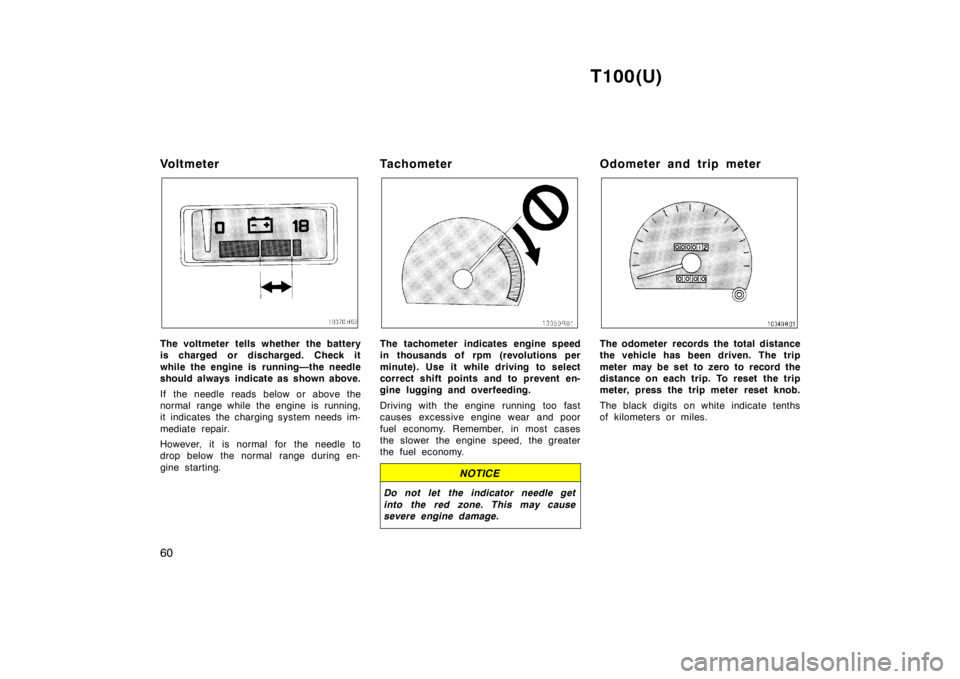
T100(U)
60
Vo l t m e t e r
The voltmeter tells whether the battery
is charged or discharged. Check it
while the engine is running—the needle
should always indicate as shown above.
If the needle reads below or above the
normal range while the engine is running,
it indicates the charging system needs im-
mediate repair.
However, it is normal for the needle to
drop below the normal range during en-
gine starting.
TachometerThe tachometer indicates engine speed
in thousands of rpm (revolutions per
minute). Use it while driving to select
correct shift points and to prevent en-
gine lugging and overfeeding.
Driving with the engine running too fast
causes excessive engine wear and poor
fuel economy. Remember, in most cases
the slower the engine speed, the greater
the fuel economy.
NOTICE
Do not let the indicator needle get
into the red zone. This may cause
severe engine damage.
Odometer and trip meter
The odometer records the total distance
the vehicle has been driven. The trip
meter may be set to zero to record the
distance on each trip. To reset the trip
meter, press the trip meter reset knob.
The black digits on white indicate tenths
of kilometers or miles.
Page 62 of 214
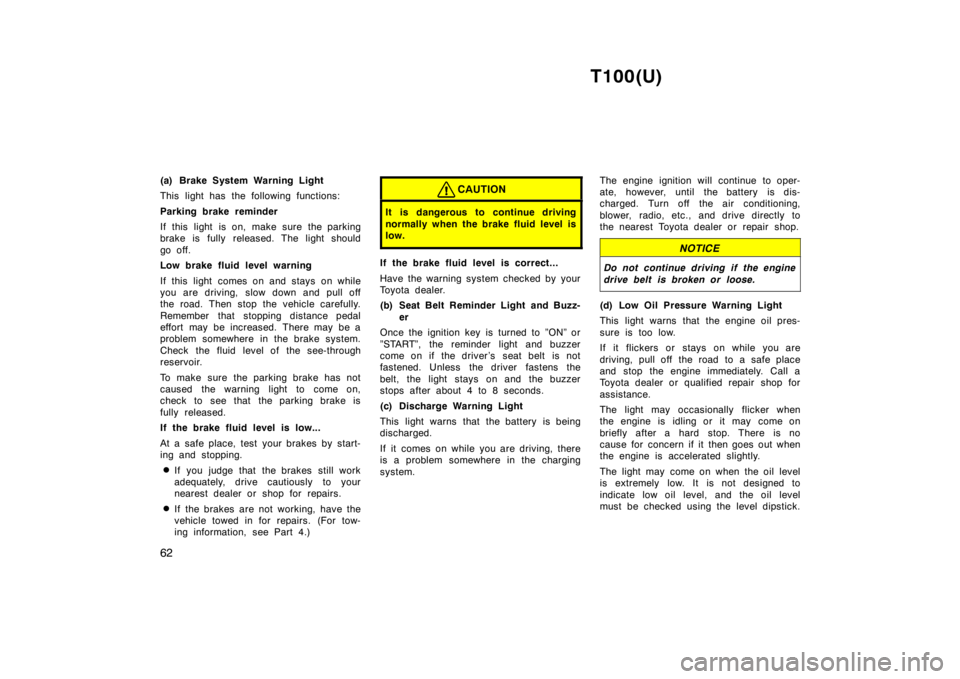
T100(U)
62
(a) Brake System Warning Light
This light has the following functions:
Parking brake reminder
If this light is on, make sure the parking
brake is fully released. The light should
go off.
Low brake fluid level warning
If this light comes on and stays on while
you are driving, slow down and pull off
the road. Then stop the vehicle carefully.
Remember that stopping distance pedal
effort may be increased. There may be a
problem somewhere in the brake system.
Check the fluid level of the see-through
reservoir.
To make sure the parking brake has not
caused the warning light to come on,
check to see that the parking brake is
fully released.
If the brake fluid level is low...
At a safe place, test your brakes by start-
ing and stopping.
� If you judge that the brakes still work
adequately, drive cautiously to your
nearest dealer or shop for repairs.
� If the brakes are not working, have the
vehicle towed in for repairs. (For tow-
ing information, see Part 4.)
CAUTION
It is dangerous to continue driving
normally when the brake fluid level is
low.
If the brake fluid level is correct...
Have the warning system checked by your
Toyota dealer.
(b) Seat Belt Reminder Light and Buzz-
er
Once the ignition key is turned to ”ON” or
”START”, the reminder light and buzzer
come on if the driver’s seat belt is not
fastened. Unless the driver fastens the
belt, the light stays on and the buzzer
stops after about 4 to 8 seconds.
(c) Discharge Warning Light
This light warns that the battery is being
discharged.
If it comes on while you are driving, there
is a problem somewhere in the charging
system. The engine ignition will continue to oper-
ate, however, until the battery is dis-
charged. Turn off the air conditioning,
blower, radio, etc., and drive directly to
the nearest Toyota dealer or repair shop.
NOTICE
Do not continue driving if the engine
drive belt is broken or loose.
(d) Low Oil Pressure Warning Light
This light warns that the engine oil pres-
sure is too low.
If it flickers or stays on while you are
driving, pull off the road to a safe place
and stop the engine immediately. Call a
Toyota dealer or qualified repair shop for
assistance.
The light may occasionally flicker when
the engine is idling or it may come on
briefly after a hard stop. There is no
cause for concern if it then goes out when
the engine is accelerated slightly.
The light may come on when the oil level
is extremely low. It is not designed to
indicate low oil level, and the oil level
must be checked using the level dipstick.
Page 144 of 214
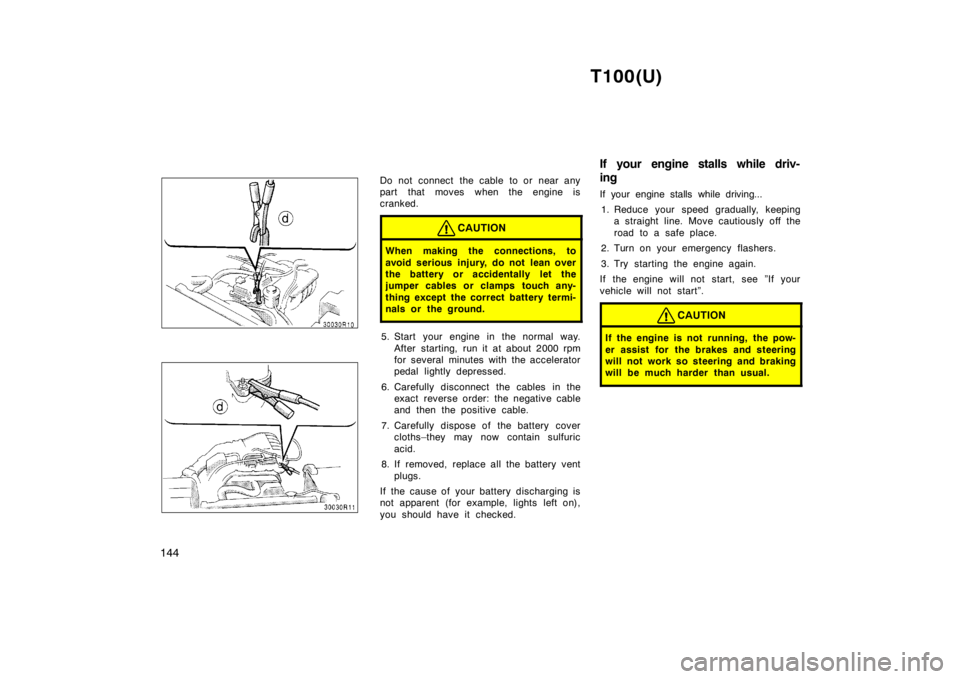
T100(U)
144
Do not connect the cable to or near any
part that moves when the engine is
cranked.
CAUTION
When making the connections, to
avoid serious injury, do not lean over
the battery or accidentally let the
jumper cables or clamps touch any-
thing except the correct battery termi-
nals or the ground.
5. Start your engine in the normal way. After starting, run it at about 2000 rpm
for several minutes with the accelerator
pedal lightly depressed.
6. Carefully disconnect the cables in the exact reverse order: the negative cable
and then the positive cable.
7. Carefully dispose of the battery cover cloths–they may now contain sulfuric
acid.
8. If removed, replace all the battery vent plugs.
If the cause of your battery discharging is
not apparent (for example, lights left on),
you should have it checked. If your engine stalls while driv-
ing
If your engine stalls while driving...
1. Reduce your speed gradually, keeping a straight line. Move cautiously off the
road to a safe place.
2. Turn on your emergency flashers.
3. Try starting the engine again.
If the engine will not start, see ”If your
vehicle will not start”.
CAUTION
If the engine is not running, the pow-
er assist for the brakes and steering
will not work so steering and braking
will be much harder than usual.
Page 189 of 214
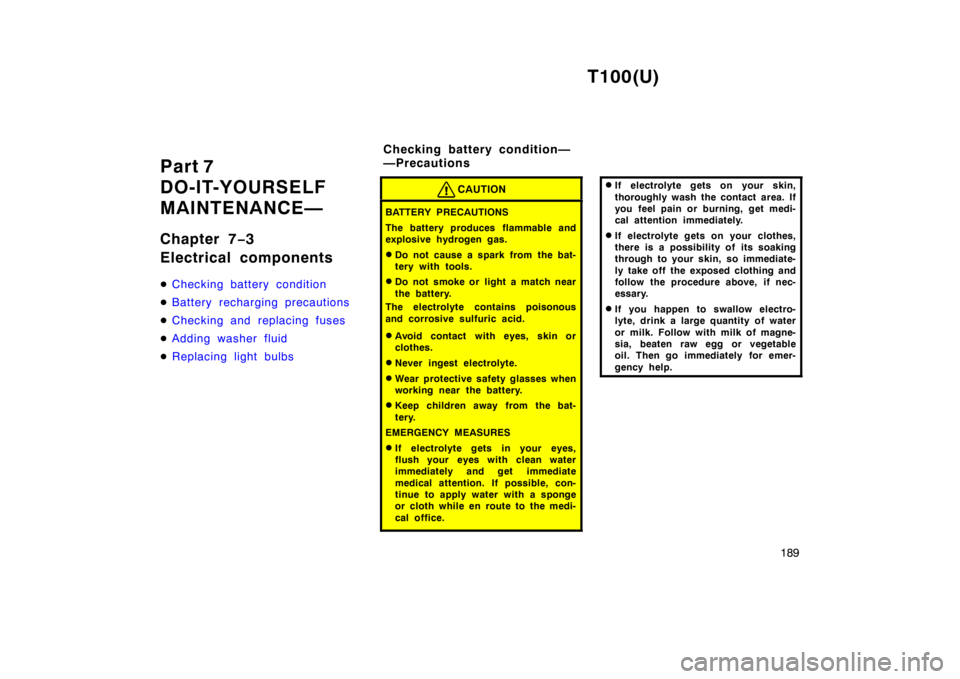
T100(U)189
Part 7
DO-IT-YOURSELF
MAINTENANCE—
Chapter 7
−3
Electrical components �
Checking battery condition
�Battery recharging precautions
�Checking and replacing fuses
�Adding washer fluid
�Replacing light bulbs
CAUTION
BATTERY PRECAUTIONS
The battery produces flammable and
explosive hydrogen gas. � Do not cause a spark from the bat-
tery with tools.
� Do not smoke or light a match near
the battery.
The electrolyte contains poisonous
and corrosive sulfuric acid. � Avoid contact with eyes, skin or
clothes.
� Never ingest electrolyte.
� Wear protective safety glasses when
working near the battery.
� Keep children away from the bat-
tery.
EMERGENCY MEASURES � If electrolyte gets in your eyes,
flush your eyes with clean water
immediately and get immediate
medical attention. If possible, con-
tinue to apply water with a sponge
or cloth while en route to the medi-
cal office.
�If electrolyte gets on your skin,
thoroughly wash the contact area. If
you feel pain or burning, get medi-
cal attention immediately.
� If electrolyte gets on your clothes,
there is a possibility of its soaking
through to your skin, so immediate-
ly take off the exposed clothing and
follow the procedure above, if nec-
essary.
� If you happen to swallow electro-
lyte, drink a large quantity of water
or milk. Follow with milk of magne-
sia, beaten raw egg or vegetable
oil. Then go immediately for emer-
gency help.
Checking battery c ondition—
—Precautions
Page 190 of 214
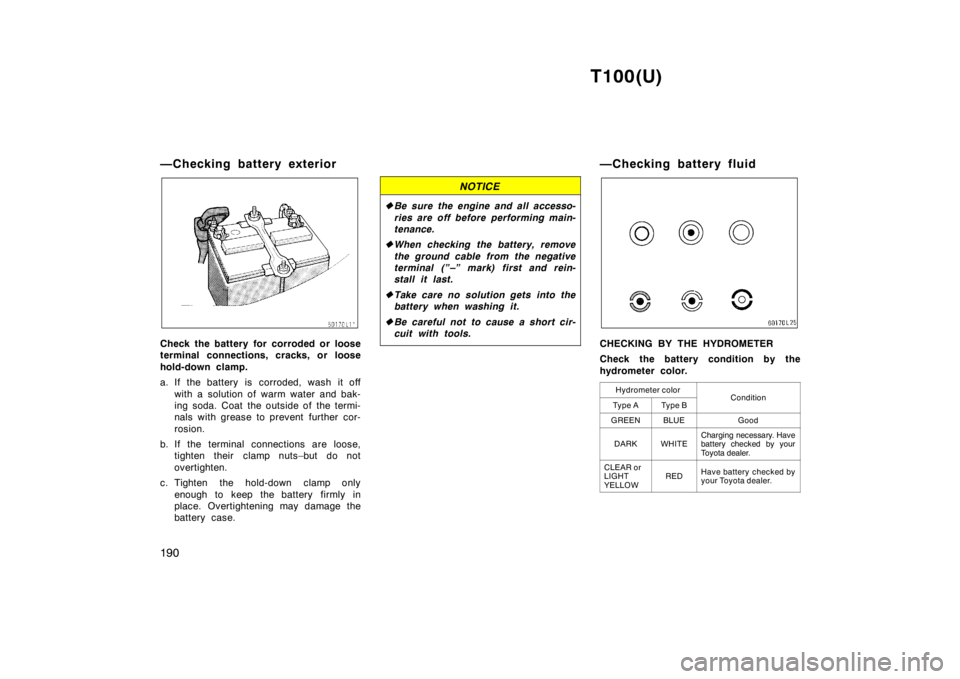
T100(U)
190
—Checking battery exterior
Check the battery for corroded or loose
terminal connections, cracks, or loose
hold-down clamp.
a. If the battery is corroded, wash it off
with a solution of warm water and bak-
ing soda. Coat the outside of the termi-
nals with grease to prevent further cor-
rosion.
b. If the terminal connections are loose, tighten their clamp nuts–but do not
overtighten.
c. Tighten the hold-down clamp only enough to keep the battery firmly in
place. Overtightening may damage the
battery case.
NOTICE
�Be sure the engine and all accesso-
ries are off before performing main-
tenance.
� When checking the battery, remove
the ground cable from the negative
terminal (”–” mark) first and rein-
stall it last.
� Take care no solution gets into the
battery when washing it.
� Be careful not to cause a short cir-
cuit with tools.
—Checking battery fluid
CHECKING BY THE HYDROMETER
Check the battery condition by the
hydrometer color.
Hydrometer color
ConditionTy p e ATy p e B
GREENBLUEGood
DARKWHITECharging necessary. Have
battery checked by your
Toyota dealer.
CLEAR or
LIGHT
YELLOWREDHave battery checked by
your Toyota dealer.
Page 191 of 214
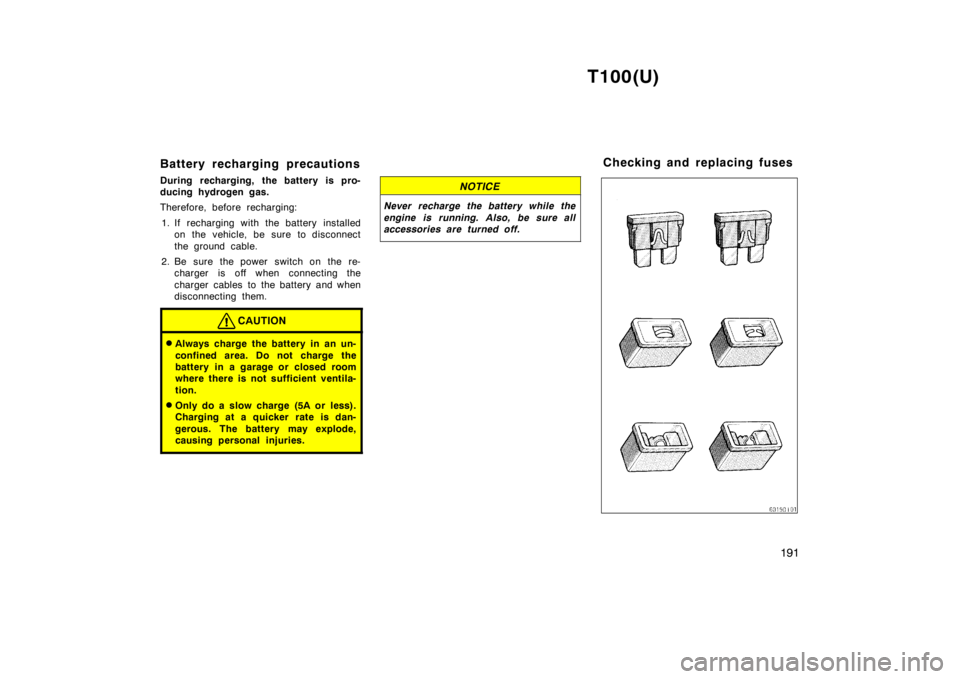
T100(U)191
Battery recharging precautions
During recharging, the battery is pro-
ducing hydrogen gas.
Therefore, before recharging:
1. If recharging with the battery installed on the vehicle, be sure to disconnect
the ground cable.
2. Be sure the power switch on the re- charger is off when connecting the
charger cables to the battery and when
disconnecting them.
CAUTION
�Always charge the battery in an un-
confined area. Do not charge the
battery in a garage or closed room
where there is not sufficient ventila-
tion.
� Only do a slow charge (5A or less).
Charging at a quicker rate is dan-
gerous. The battery may explode,
causing personal injuries.
NOTICE
Never recharge the battery while the
engine is running. Also, be sure all
accessories are turned off.
Checking and replacing fuses
Page 202 of 214

T100(U)
202
ENGINE LUBRICATION
Oil capacity (drain and ref
ill),
L (qt., Imp. qt.):
Two-wheel drive models 3RZ −FE engine
With filter 5.5 (5.8, 4.8)
Without filter 4.8 (5.1, 4.2)
5VZ −FE engine
With filter 5.2 (5.5, 4.6)
Without filter 4.9 (5.2, 4.3)
Four-wheel drive models With filter 4.7 (5.0, 4.1)
Without filter 4.4 (4.7, 3.9)
Oil grade: API grade SH, ”Energy-Conserving II”
or SJ, ”Energy-Conserving” multigrade
engine oil or ILSAC multigrade engine
oil is recommended.
Recommended oil viscosity (SAE):
COOLING SYSTEM
Total capacity, L (qt., Imp. qt.): Two-wheel drive models
With manual transmission 3RZ −FE engine
8.7 (9.2, 7.7)
5VZ −FE engine
10.0 (10.6, 8.8)
With automatic transmission
3RZ −FE engine
9.0 ( 9.5, 7.9)
5VZ −FE engine
9.9 (10.5, 8.7)
Four-wheel drive models With manual transmission
10.0 (10.6, 8.8)
With automatic transmission 9.9 (10.5, 8.7)
Coolant type: With ethylene-glycol antifreeze
(Do not use alcohol type.)
BATTERY
Open voltage �
at 20 �C (68 �F):
12.6—12.8 V Fully charged
12.2—12.4 V Half charged
11.8—12.0 V Discharged
� : Voltage that is checked 20 minutes after
the key is removed with all the lights
turned off
Charging rates: 5 A max. CLUTCH
Pedal freeplay, mm (in.):
5—15 (0.2—0.6)
Fluid type:
SAE J1703 or FMVSS No.116 DOT 3
MANUAL TRANSMISSION
Oil capacity, L (qt., Imp. qt.): 3RZ −FE engine
2.6 (2.7, 2.3)
5VZ −FE engine
Two-wheel drive models
2.6 (2.7, 2.3)
Four-wheel drive models 2.2 (2.3, 1.9)
Page 206 of 214

T100(U)
206
Fuses
Fuses (type A)
1. HEAD (LH) 10 A: Left-hand headlight
2. HEAD (RH) 10 A: Right-hand headlight
3. A/C 10 A: Air conditioning cooling sys-
tem
4. EFI 15 A: Multiport fuel injection sys-
tem/sequential multiport fuel injection
system, electronically controlled auto-
matic transmission system
5. HAZ-HORN 15 A: Emergency flashers,
horns
6. DOME 15 A: Interior light, personal
lights, step lights, ignition switch light,
radio, cassette tape player, power an-
tenna, clock7. HEAD (LH-HI) 10 A: Left-hand head-
light (high beam)
8. HEAD (RH-HI) 10 A: Right-hand head-
light (high beam)
9. HEAD (LH-LO) 10 A: Left-hand head-
light (low beam)
10. HEAD (RH-LO) 10 A: Right-hand head-
light (low beam)
11. ENGINE 10 A: Charging system, cruise
control system
12. IGN. 7.5 A: Charging system, dis-
charge warning light, multiport fuel in-
jection system/sequential multiport fuel
injection system13. TAIL 15 A: Tail lights, parking lights,
license plate lights, instrument panel
lights, glovebox light
14. WIPER 20 A: Windshield wiper and
washer
15. GAUGES 10 A: (except discharge warn-
ing light), A.D.D. control system, cruise
control system, back-up lights, power
door lock system
16. STOP 15 A: Stop lights, High-mounted
stoplight, cruise control system, elec-
tronically controlled automatic transmis-
sion system